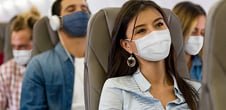Traveling with your furry friend or pet is possible. Today more and more airlines are making arrangements for passengers to take pets, especially dogs and cats on board.
But in addition to adhering to the IATA Live Animals Regulations, some countries and airlines have their own specific requirements for the carriage of live animals. This is why it is very important that you check the specific procedures that will apply to your trip with the airline directly.
You will find below answers to the most frequently asked questions related to animal transport by air. For more information, please consult our Traveler's Pet Corner page.
Frequently Asked Questions
Traveling with your dog or cat in cabin
Please see Guidance for Passengers Traveling with their Dog or Cat in the Cabin
Where can I find about the documentation and vaccines needed?
See this list of country specific regulations for shipping pets.
Is my pet old enough to travel?
Animals must be at least eight weeks old and fully weaned before traveling by air. Many airlines require that your pet must be older before traveling internationally. It is essential to contact the airline you are planning on flying with for more information.
What size of travel container will my pet need?
It is important you purchase the right sized and compliant container for your animal. There are specific container sizes applicable to cats and dogs. Allow your pet to have enough space to turn around normally while standing, to stand and sit fully, and to lie in a natural position. Refer to the guidance for dimensions of containers.
Are cargo holds safe for pets?
Most people would prefer to fly with their pet in the cabin of the aircraft however, this is not always possible, especially if your pet is over a certain size or if the airline does not allow pets in cabin. The only option left is for your pet to travel in the cargo hold.
Do not worry, cats and dogs actually travel better this way because it is quieter and they will rest in a darkened environment. Despite all the fears about airline pet cargo travel, millions of animals are carried safely every year.
Should I feed my pet before travel?
A full stomach might be uncomfortable for your dog during travel. Feed your pet a light meal and a small drink approximately two hours before dispatch and exercise your pet immediately before it goes into its container. While it's best to refrain from feeding your dog right before the flight, you can (and should) continue to give him water right up to the time of travel.
Can I sedate my pet?
We do not encourage the use of sedatives and tranquilizers in animals being transported either in cabin or cargo hold due to the potential for adverse effects during transport. This view is endorsed by veterinary organizations such as the American Veterinary Medical Association, which provides more information on this topic.
DID YOU KNOW?
NEW! Introducing the Guidance for Passengers Traveling with Dog or Cat in the Cabin, providing travelers information on their pets’ suitability for travel, required advance preparations and the appropriate container needed to ensure your furry friend’s comfort and safety.
Every year millions of animals travel safely and securely by air. Animal owners and shippers rely heavily on airlines to carry their precious cargo. Our focus is on ensuring the safety and welfare of animals' jet-petting around the world. The IATA Live Animal Regulations is the standard for transporting live animals by commercial airlines.
And imagine, giraffes are the only animals that cannot be transported by air!







